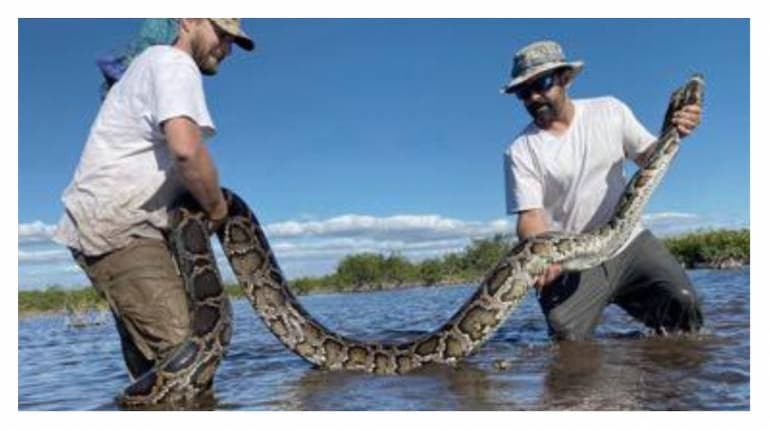



A team of US researchers captured the largest Burmese python ever discovered in the state, Florida officials announced on Thursday.
The female serpent, is almost 18 feet long and weighed about 98 kg, according to the Conservancy of Southwest Florida. This species is considered to be an invasive one in Florida, researchers said.
To capture it, researchers had to wrestle with the ginormous snake for 20 minutes, reported New York Post. It was then left in a freezer until April this year.
“Look at the scale of the problem” - some 18 feet of very dead invasive python - the largest ever removed from Florida, complete with 120 eggs and adult white-tailed deer hooves - at @ConservancySWFL, which is working to remove them from the Everglades. pic.twitter.com/Zm0xHsZqlb— Amy Bennett Williams (@AmySWFL) June 22, 2022
During examination, the snake was found to have 122 eggs in its abdomen. With this the python broke another record for the most eggs female python can produce in a breeding cycle, the publication stated.
Moreover, researchers also found “hoof cores” inside the snake’s stomach indicating that it's last meal was a white tailed deer.
Read more: Snake bites man in the butt as he sat playing video game on toiletBut how was this Burmese python found?
The wildlife biologists revealed that they used a unique research programme that uses radio transmitters implanted in male snakes to lead them to breeding grounds where “large, reproductive females” can be removed to stop their eggs from hatching in the wild.
Speaking about this process, Ian Bartoszek, wildlife biologist and environmental science project manager for the Conservancy told New York Post, “How do you find the needle in the haystack? You could use a magnet, and in a similar way our male scout snakes are attracted to the biggest females around."
“The removal of female pythons plays a critical role in disrupting the breeding cycle of these apex predators that are wreaking havoc on the Everglades ecosystem and taking food sources from other native species,” he told the publication. “This is the wildlife issue of our time for southern Florida.”
Discover the latest Business News, Sensex, and Nifty updates. Obtain Personal Finance insights, tax queries, and expert opinions on Moneycontrol or download the Moneycontrol App to stay updated!
Find the best of Al News in one place, specially curated for you every weekend.
Stay on top of the latest tech trends and biggest startup news.